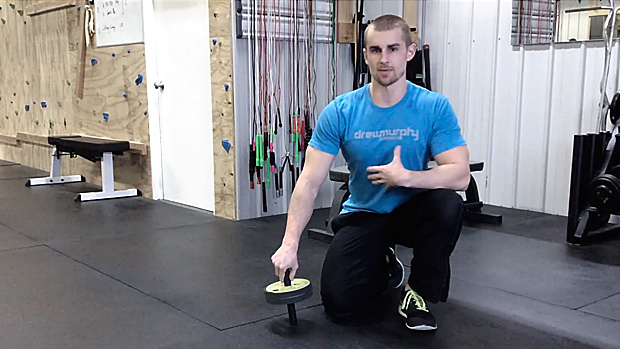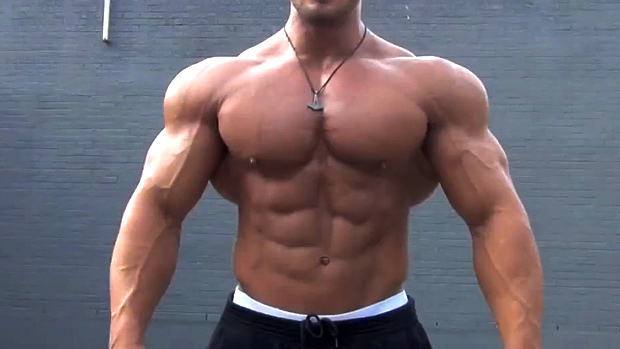Visualize yourself doing a set of bench presses. After nine reps you hit a sticking point and the weight won't budge. What happens next could be very important and revealing. You see, there are two kinds of people when it comes to sticking points. There are those who can still get through the sticking point after a ten-second death struggle, and those who hit the wall and die instantly. Which one are you?
In seminars, I sometimes ask those who identify themselves as belonging to the first category to move to the left side of the room, and those who belong to the second category to move to the other side of the room. Immediately, an interesting phenomenon becomes apparent. On the left, we have people with ideal weightlifting levers (called dolicomorphs), and on the right, their more brachiomorphic (long-limbed) peers.
Brachiomorphs, those long-armed benchers who hit the wall and crash, are prone to thinking that they're genetically disadvantaged. But are they really? Depends on the context. Long-levered athletes can express their strength much more successfully on the playing field than in the weight room. For example, Michael Jordan has a startling vertical jump, yet I wonder what he can parallel squat? Probably nothing to write home about. When you're 6'6", parallel is a long way down!
The "real life" advantages of long levers has been aptly described in the following passage from Applied Anatomy and Biomechanics in Sport (© 1994, Blackwell Scientific Publications, p.p. 81-82):
"In some sports, such as weightlifting, athletes with short levers will have an advantage over those who possess long levers, because the weight only needs to be lifted through a shorter distance (Hart, et al. 1991). On the other hand, if an athlete requires a long powerful stroke, such as in swimming, canoeing or rowing, then a longer lever, provided it is accompanied by the muscular power to propel it, has an advantage in these types of sports. The same point can be made in other sports where hitting or throwing are important. For example, velocity generation for a tennis serve, volleyball spike, or a baseball pitch will all be higher for long-levered athletes, if they have the muscle power to rotate the longer segments."
Along the same lines, I recently rediscovered a very interesting article by MI Popichev of the former Soviet Union (1). Popichev advocated a novel approach to improving the vertical jumping ability of young volleyball players by accommodating training strategies to each player's body type. All players were assigned to one of four groups based on the relative length of the trunk, thigh, and lower leg. Popichev then assigned training strategies for each group based on body type.
Group One
Trunk: long
Thigh: long
Lower leg: short
Training Strategy: Speed exercises for trunk extensors; speed-strength exercises for quads; strength exercises for lower legs and feet.
Group Two
Trunk: short
Thigh: long
Lower leg: short
Training Strategy: Speed-strength exercises for trunk extensors; speed exercises for quads; strength exercises for lower legs and feet
Group Three
Trunk: short
Thigh: short
Lower leg: long
Training Strategy: Speed strength exercises for quads and trunk extensors; speed exercises for lower legs and feet.
Group Four
Trunk: long
Thigh: short
Lower leg: long
Training Strategy: Speed exercises for trunk and shin-foot extensors; speed-strength work for quads.
As you can see, when a "segment" is long, either speed or speed-strength exercises were emphasized. Alternatively, short segments were exposed to pure strength training instead. Apparently, I wasn't the first person to individualize training speed based on leverages. In fact, athletes and coaches in the sport of powerlifting have been forced to think outside the box due to the radical thinking of Westside Barbell's Louie Simmons. Check it out...
Powerlifting Goes "Outside the Box"
Until relatively recently, the sport of powerlifting was dominated by a fairly unified training strategy. The lion's share of time and energy was spent on the three competitive lifts (squat, bench press, and deadlift), while whatever energy resources remained were devoted to assistance lifts such as lat pulldowns, abdominal exercises, calf raises, triceps extensions, and so on.
The predominant progression scheme involved moving from a month of training devoted to five sets of five, moving on to perhaps three sets of three, and continuing to two sets of one as competition neared. In other words, as the cycle progresses, you moved from lower to higher levels of intensity and volume would gradually decrease at the same time.
The only significant alternative to this traditional strategy has emerged through the success of Westside Barbell Club in Columbus Ohio, under the coaching of Louie Simmons. The Westside approach features a much greater emphasis on assistance lifts, with the three competitive lifts assigned to relatively low (50 to 70%) intensities performed at accelerative speeds. Using this strategy, Westside has produced twenty-one lifters with totals exceeding 2100 pounds and six lifters at or above the 2200-pound mark.
Yet despite the success of Westside, many dominant lifters (including Ed Coan, arguably the greatest powerlifter of all time) still prefer the traditional approach described earlier. Why? My personal suspicion is this:
1) By definition, very few athletes have "ideal" levers for their chosen endeavor. Simmons has found a methodology that works for the majority rather than the minority. In particular, the concerted use of elastic resistance in conjunction with standard barbell training develops the capacity to "outrun" the sticking point. Remember, long-levered athletes have more profound sticking points than do their shorter levered peers.
2) Dolicomorphic lifters don't develop significant weaknesses when they restrict themselves to a small number of compound exercises. Therefore, these people with great levers can do quite well simply focusing on the big three lifts.
Of course, powerlifters also employ technical strategies to further shorten their levers, such as utilizing a low bar placement in the squat, employing a wide grip in the bench press, and so on. Nevertheless, if your training strategy capitalizes on your unique leverage profile, you'll be that much better off.
Why Squatting Gives Some People a Big Ass
Here's a funny thing: when you have good weightlifting levers, you can get relatively equal quad, hamstring, and glute development just from squatting. On the other hand, if you have long femurs (the bones in the upper legs), relying solely on the squat will give you a big can! Here's why:
As you start to bend your knees, you quickly exhaust your ankle's range of motion or ROM. The only thing you can do now is to sit back. As you do so, it becomes necessary to lean forward to prevent yourself from falling over backward. And of course, leaning forward recruits those glutes like nobody's business. If you want more stress on the quads, you'll need to squat in a manner that maximizes knee flexion. Problem is, for someone with long femurs, every degree of knee flexion requires more range of motion in the ankle as compared with someone with short femurs.
If you're ever in the midst of a large group of athletes from various sports, ask everyone who's had knee surgery to raise their hands. The tallest people will all raise their hands. Long levers put more forces on their corresponding joints.
What Large ROM People Can Learn From Large ROM Exercises
Okay, now that we've considered various related phenomenon, here's my essential premise. In the same way that faster lifting speeds work better for exercises that have larger ROMs, faster lifting speeds also work better for people that have larger ROMs. Accordingly, slow speed lifting (typically using heavier loads) is generally more effective for dolicomorphic (smaller ROM) lifters.
This doesn't mean that if you have long levers, you should rely exclusively on accelerative or fast lifting strategies! What I'm suggesting is that you should carefully evaluate your training and see if you're devoting sufficient priority to faster movement speeds.
But what about Olympic Weightlifting?
Athletes who are successful in this sport have short levers. Doesn't this contradict the argument that dolicomorphs should emphasize heavy/slow lifting?
There are several variables to consider with respect to this example. First, Olympic weightlifting (unlike powerlifting) requires the apparatus to be accelerated. Second, explosive strength (the primary motor quality required for success in the sport) is at least in part determined by maximal strength levels. In fact, if you remove confounding factors such as support equipment, stance width, depth, and bar placement, most elite Olympic lifters have squat performances which approach those of their powerlifting peers.
Interestingly enough, Louie Simmons has argued for the idea of less accelerative work and more maximal strength work for these athletes (2), and I've used just such a strategy with several Olympic lifters with very satisfying results.
What Strength Coaches Can Learn From Freaks And Geeks
If the majority of athletes (by definition) have poor weightlifting levers, why subject them to strength training methods and standards that were designed for athletes with ideal weightlifting levers?
For the most part, long-levered athletes shouldn't be forced to the powerlifting standard of squatting to parallel. Doing so requires them to squat through a much larger range of motion than someone with shorter levers. The same goes for bench pressing. The majority of athletes are required to apply the most force when the limb is nearly extended, not when it's fully flexed. The selection of strength training exercises and loading parameters should reflect this reality.
Why do Throwers Love the Power Clean?
In track and field, the power clean has long been a staple in the training programs of discus throwers. If you compare the clean to all other lifts traditionally performed by these athletes (who are brachiomorphic due to the biomechanical realities of the event), the only distinguishing characteristic is that the power clean is accelerative by definition, while the other lifts are generally done with heavy weight and at slow speeds.
Discus throwers tend to love cleans and hate bench pressing because their levers predispose them for success in the former lift and failure in the latter exercise. However, partial ROM bench pressing (where the bar is brought down to a rolled-up towel on the chest) performed acceleratively changes the equation entirely, making the bench press a worthwhile lift for these athletes.
Recommendations
Long-limbed lifters can't expect to use the same methodologies as their short-limbed counterparts and expect the same results! Below are the essential differences between training strategies for both types of lifters:
Brachiomorphic Body Type (long limbs)
The lifting emphasis should be on moderate/accelerative work. This body type needs more flexibility training and needs to emphasize distal muscle groups (those toward the extremities). Brachiomorphs need to spend more time on distal muscles since their poor levers predispose them to weaknesses. That means more supplementary work and not just a focus on the major lifts.
Dolicomorphic Body Type (short limbs)
The lifting emphasis here should be heavy/slow. Those with this body type should emphasize proximal muscle groups (those closer to center or core of the body). Dolicomorphs should also emphasize, but not completey restrict themselves to, the big compound movements like squats, benches presses and deadlifts.
ConclusionThe suggestions I've arrived at in this article aren't intended to be applied in an all-or-nothing manner! Body type is but one of many factors which must be considered when developing training strategies. Other factors include fiber-type ratio, muscle architecture, health status, and postural considerations. Nevertheless, your training decisions must take your body type into consideration if you wish to experience maximal progress.
References
1) Popichev, M.I., Body Types and Jumping Ability in Teen-Age Volleyball Players. Fitness and Sports Review International, Vol 27, number 5, 10/92.
2) Simmons, L. How to Regain Top Form- Part II. Milo: A Journal for Serious Strength Athletes. Volume 3, Number 1, April 1995, p.p. 26-27.




